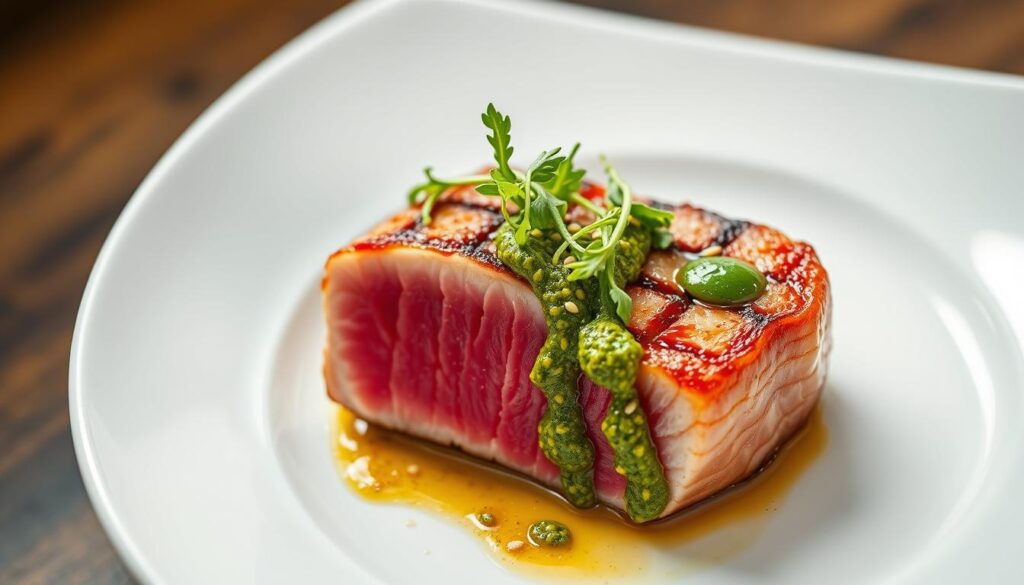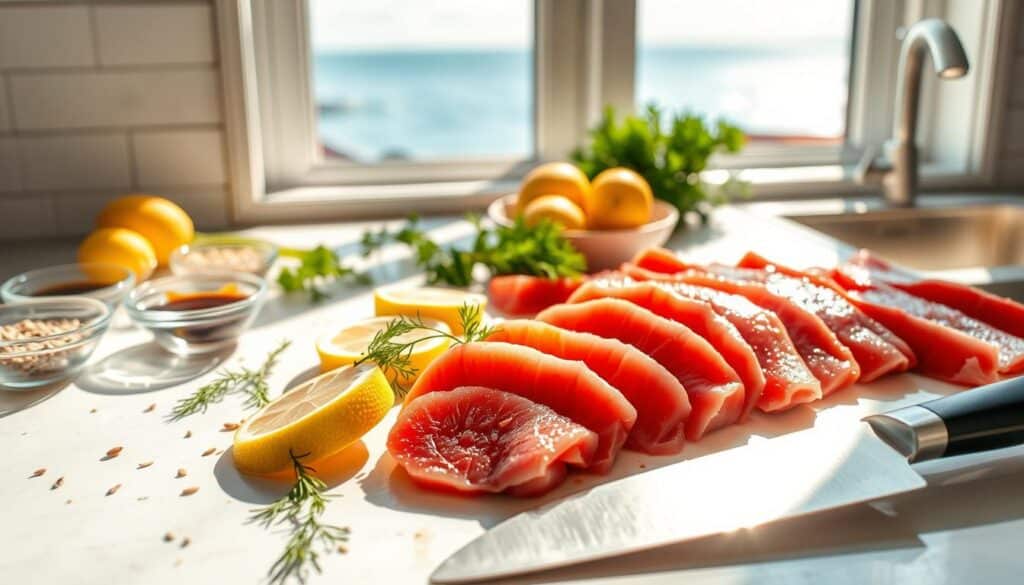Imagine the thrill of transforming a fresh Ahi Tuna Recipe into a gourmet masterpiece right in your kitchen. This guide will walk you through the simple steps to achieve a perfectly seared tuna that rivals any restaurant dish. Whether you’re a cooking novice or an experienced chef, you’ll learn how to elevate your culinary skills with this easy-to-follow recipe.
Thank you for reading this post, don't forget to subscribe!Quality ingredients and precise timing are key to unlocking the full flavor and texture of your tuna. With just a few minutes of cooking time, you can create a dish that’s both healthy and delicious. Plus, discover how the right sauce can take your meal from ordinary to extraordinary.
Stay safe and confident in the kitchen with our FDA-recommended guidelines for cooking tuna. Learn how to prepare a fresh, vibrant salsa with just eight ingredients and explore the versatility of your dish, whether as a salad or a main course.

Ready to get started? This recipe serves two and is ready in under 15 minutes. For more tips on achieving that perfect crisp, check out our guide on making a simple and crispy fish fry.
Key Takeaways
- Transform fresh ahi tuna into a gourmet dish with simple steps.
- Quality ingredients and precise timing ensure optimal flavor and texture.
- The right sauce can elevate your dish to restaurant quality.
- Follow FDA guidelines for safe and delicious cooking.
- Prepare a fresh, vibrant salsa with just eight ingredients.
Getting Started: Preparing Your Ingredients
Starting your culinary journey begins with selecting the freshest ingredients. For this dish, you’ll need 1 lb. of sushi-grade tuna, ensuring it’s sashimi-quality for the best results. Pair this with seasonal produce like sliced zucchini for a refreshing crunch.
Exploring Fresh Ahi Tuna and Essential Produce
Dice the tuna into ¾-inch cubes for even marinating. Arrange zucchini slices attractively for a vibrant presentation, perfect for a rice bowl or a bed of greens.
Gathering Sauces, Zest, and Garnishes
Enhance your dish with WATCHAREE’S Pad Thai Sauce, adding it gradually to taste. Garnish with lime zest, sesame seeds, and consider adding mango or avocado for extra flavor and texture.
| Ingredient | Quantity | Preparation |
|---|---|---|
| Sushi-grade tuna | 1 lb. | Diced into ¾-inch cubes |
| Zucchini | 1 medium | Thinly sliced |
| WATCHAREE’S Pad Thai Sauce | 2-3 tbsp. | Added gradually |
| Lime zest | 1 tsp. | Sprinkled as garnish |
| Sesame seeds | ½ tsp. | Black and white, for garnish |
| Avocado | 1 | Diced (optional) |
For allergen-conscious choices, opt for gluten-free soy sauce. Store any leftovers in an airtight container for up to 2 days. Explore more recipes like ahi tuna sashimi or chicken in tomato sauce for varied meals.

Selecting the Perfect Ahi Tuna and Other Essentials
Choosing the right ingredients is the first step to creating a truly delicious dish. When it comes to ahi tuna, understanding what makes it top quality is crucial. Freshness, color, and texture all play significant roles in ensuring your dish turns out flavorful and visually appealing.
Understanding Ingredient Quality and Allergen Information
Ahi tuna is graded based on appearance, size, shape, color, texture, and fat content. Grade 1 ahi tuna is the highest quality, with deep red, almost translucent flesh rich in flavorful fat. It’s essential to select sushi-grade tuna, as it’s safe for raw consumption. Always check the packaging for allergen information and nutrition facts to ensure your dish is safe and healthy.
Fresh ahi tuna should have a bright, ruby-red color with a shiny sheen. Avoid tuna with a dull, brown appearance, as it may indicate decomposition. The FDA allows the use of carbon monoxide to preserve the color of fresh tuna, so look for proper labeling. Bright red tuna sold far from the ocean might have been frozen or treated with gas, which can affect its freshness.

Impact of Fresh vs. Frozen Tuna
Fresh tuna offers superior flavor and texture compared to previously frozen tuna. However, if fresh isn’t available, frozen tuna can still be used, though it may lack some of the vibrant color and freshness. Always consult your fishmonger to ensure you’re getting the best possible quality, whether fresh or frozen.
Industry Standards and Quality Checks
Industry standards, like those from Home Chef, emphasize the importance of sourcing premium fish. When selecting tuna, consider factors like sourcing transparency and quality checks. If necessary, substitute ingredients, but always maintain high standards. For inspiration, explore recipes like ahi tuna sushi roll or sausage and rice for varied meal ideas.
Incorporating Essential Elements
Enhance your dish with sauces like WATCHAREE’S Pad Thai Sauce, adding it gradually for balanced flavor. Garnish with lime zest and sesame seeds for a vibrant presentation. Consider adding mango or avocado for extra texture and flavor. These elements will elevate your dish’s appearance and taste, making it a delightful experience for your guests.
By focusing on quality ingredients and thoughtful preparation, you can create a dish that’s both nutritious and flavorful. Whether you’re preparing a simple meal or an elaborate feast, the right ingredients and a little creativity will make all the difference.
Perfect Your Technique with Ahi tuna recipe -sear
Mastering the art of searing ahi tuna can elevate your dish from ordinary to extraordinary. Follow these simple steps to achieve a perfectly seared crust while maintaining a tender interior.
Step-by-Step Searing Process
Begin by patting the tuna dry with a paper towel to remove excess moisture. Lightly season with salt and pepper. Heat a nonstick pan over medium-high heat and add a drizzle of olive oil. Sear the tuna for 1-2 minutes per side for medium-rare, ensuring a well-developed crust.
Cooking Times and Safety Tips
Cook the tuna to an FDA-recommended internal temperature of 145°F for food safety. Use a meat thermometer to check the internal temperature. For medium-rare, cook for 1-2 minutes per side. Always handle the tuna gently to avoid breaking the delicate flesh.
Innovative Saucing and Presentation
Add a flavorful twist with WATCHAREE’S Pad Thai Sauce. Serve the seared tuna over a bed of rice or mixed greens for a vibrant presentation. Garnish with sesame seeds and a sprinkle of lime zest for added texture and color. Consider adding diced avocado or mango for extra creaminess and flavor.
Experiment with different sauces and garnishes to create a dish that reflects your personal style. Whether you prefer a classic approach or a modern twist, the key to a great sear is attention to detail and a focus on quality ingredients.
Conclusion
Experimenting with fresh flavors and techniques can turn your ahi tuna dish into a culinary masterpiece. Remember, the key to a perfect sear lies in quality ingredients and precise timing.
Always prioritize food safety by cooking your tuna to the FDA-recommended internal temperature of 145°F. This ensures both flavor and safety. Don’t forget to let your creativity shine by adding vibrant garnishes like lime zest and sesame seeds for a stunning presentation.
For more meal ideas, consider trying a refreshing tuna salad or exploring other proteins like braised chicken. Share your creations and enjoy the journey of culinary discovery!
FAQ
What are the best ingredients to use for an ahi tuna bowl?
For an ahi tuna bowl, fresh, sushi-grade tuna is essential. Pair it with short-grain rice, diced avocado, and toasted sesame seeds for added flavor and texture. Don’t forget to drizzle with a high-quality soy sauce or ponzu for a burst of umami.
Can I substitute chicken for tuna in this recipe?
While chicken can be a great protein option, it won’t replicate the delicate flavor and texture of ahi tuna. However, if you prefer chicken, marinate it in soy sauce, ginger, and garlic for a similar flavor profile before grilling or pan-searing.
How do I save time when preparing this dish?
Prep your ingredients ahead of time! Cook the rice, slice the avocado, and toast the sesame seeds in advance. Store them in airtight containers until you’re ready to assemble the bowls.
Can I meal prep this recipe for the week?
Yes! Cook the rice and store it in the fridge for up to 3 days. Slice the tuna just before serving to maintain freshness. The sesame seeds and sauces can also be prepped and stored separately to keep everything fresh.
How do I ensure the tuna is safe to eat?
Always purchase sushi-grade tuna from a trusted source. Store it in the refrigerator at a temperature below 40°F (4°C) and consume it within a day of purchase for the best quality and safety.
What’s the best way to customize this bowl to my taste?
Feel free to get creative! Add diced veggies like carrots or cucumbers, a sprinkle of furikake, or a drizzle of sriracha mayo. You can also serve it over a bed of mixed greens for a lower-carb option.
Can I use jarred sauces instead of making my own?
Absolutely! Jarred ponzu or teriyaki sauce can save time and still deliver great flavor. Look for brands with minimal added sugars and preservatives for a healthier option.
How do I achieve the perfect sear on the tuna?
Pat the tuna dry with a paper towel to remove excess moisture. Heat a skillet over medium-high heat, add a small amount of oil, and sear the tuna for 1-2 minutes on each side for a rare finish. Let it rest before slicing.
Can I serve this dish at a dinner party?
This ahi tuna bowl is perfect for entertaining! It’s elegant, flavorful, and can be easily scaled up for a crowd. Consider setting up a build-your-own bar with all the fixings for a fun and interactive experience.
How do I store leftovers properly?
Store the tuna, rice, and toppings in separate airtight containers in the fridge. The tuna will keep for up to a day, while the rice and veggies can be stored for up to 3 days. Reassemble just before serving for the freshest taste.
There are no reviews yet. Be the first one to write one.

